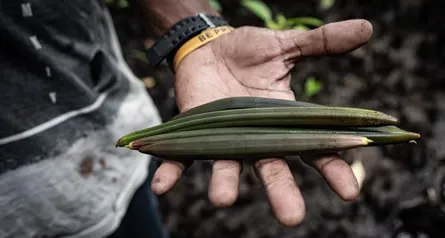In the remote corners of the Solomon Islands, a remarkable environmental story is unfolding—one that combines community spirit, ecological restoration, and the resilience of nature itself. For decades, coastal areas in the region have faced deforestation, erosion, and the slow disappearance of mangrove forests. These crucial ecosystems protect shorelines, support biodiversity, and sustain local livelihoods. Yet, thanks to the extraordinary efforts of a visionary leader, over 40,000 square meters of mangroves have been successfully restored, bringing hope to both nature and people.
This story is more than a tale of replanting trees. It is a testament to how one individual, driven by dedication and love for the environment, can ignite a movement that benefits entire communities and ecosystems. From the early days of struggling seedlings to thriving forests now teeming with wildlife, the journey offers lessons in perseverance, science, and the power of collaboration.
Table of contents
- The Importance of Mangroves
- A Leader’s Vision
- The Restoration Process
- The Results: A Thriving Ecosystem
- Positive Impact on Communities
- A Model for Global Environmental Action
- Global Significance
- Inspiration for the Next Generation
- Looking Forward: The Future of Mangrove Conservation
- Conclusion: A Living Testament to Nature and Leadership
The Importance of Mangroves
Before delving into the restoration efforts, it’s essential to understand why mangroves are so critical:
- Coastal Protection: Mangroves act as natural buffers against storms, waves, and rising sea levels. Their dense root systems prevent soil erosion, safeguarding both communities and agriculture.
- Biodiversity Hotspots: Mangroves provide habitat for countless species, including fish, crabs, birds, and insects. They serve as nurseries for marine life that supports local fisheries.
- Carbon Sequestration: Mangrove forests are among the most carbon-dense ecosystems on Earth. Restoring them helps fight climate change by absorbing significant amounts of CO₂.
- Livelihoods: Local communities rely on mangroves for food, firewood, and raw materials. Healthy forests translate to stronger economies and more resilient societies.
Unfortunately, in the Solomon Islands, mangroves have faced multiple threats, from commercial logging and coastal development to natural disasters. Loss of these forests meant not just environmental degradation but also a decline in food security and increased vulnerability to storms.
A Leader’s Vision
The restoration effort began with one local leader who recognized the importance of mangroves long before it became a global concern. With a background in environmental science and deep ties to the community, this leader understood that restoring mangroves would require more than planting trees—it demanded education, collaboration, and patience.
Early efforts focused on:
- Mapping degraded areas to prioritize locations most at risk.
- Identifying suitable mangrove species that would thrive in local conditions.
- Engaging the community, including schools, fishermen, and elders, to foster a sense of ownership.
The vision was clear: restore the coastline while empowering the community to take charge of its environment.
The Restoration Process
Restoring mangroves is both an art and a science. Unlike planting ordinary trees, mangrove restoration requires understanding tidal patterns, soil salinity, and species compatibility.

Step 1: Site Preparation
Degraded areas were cleared of debris, invasive species, and pollutants. Workers carefully monitored soil conditions, ensuring that seedlings would have the best chance of survival.
Step 2: Seedling Selection and Nursery Development
Local nurseries were established to grow mangrove seedlings. These nurseries not only produced healthy plants but also became educational hubs where locals learned about mangrove ecology.
Step 3: Community Planting Events
Planting days were transformed into community celebrations. Families, students, and local organizations came together to plant seedlings along the shoreline. These events reinforced environmental stewardship and created lasting memories tied to the forest’s growth.
Step 4: Maintenance and Monitoring
Mangroves require ongoing care. Volunteers ensured seedlings were protected from tidal waves, pests, and human interference. Regular monitoring helped identify challenges early, ensuring high survival rates.
Step 5: Scientific Tracking
Researchers collaborated with the community to monitor growth, biodiversity, and carbon sequestration rates. This data not only validates the success of the project but also contributes to global knowledge on mangrove restoration.
The Results: A Thriving Ecosystem
The effort has led to extraordinary results:
- 40,000 m² of mangrove forest now flourishing along the Solomon Islands’ coast.
- Return of wildlife, including birds, crabs, and fish species previously scarce due to habitat loss.
- Improved shoreline stability, reducing erosion and protecting nearby villages.
- Enhanced community engagement, as locals continue to participate in care, education, and advocacy.
What was once a degraded, vulnerable coastline is now a thriving ecosystem, demonstrating that ecological recovery is possible even in areas once considered lost.
Positive Impact on Communities
Restoring mangroves is not only an environmental victory but also a social one. Communities have experienced multiple benefits:
- Fisheries Recovery: Mangroves serve as breeding grounds for fish, boosting local fishing yields.
- Education and Awareness: Schools have integrated mangrove studies into curricula, fostering environmental awareness among children.
- Tourism Opportunities: Eco-tourism initiatives now allow visitors to explore restored mangrove forests, supporting local businesses.
- Disaster Preparedness: Healthier coastlines reduce the impact of storms and flooding, increasing community resilience.
By intertwining ecological restoration with human well-being, the project demonstrates that environmental action and social development can go hand in hand.
A Model for Global Environmental Action
This project in the Solomon Islands serves as a blueprint for similar efforts worldwide. Key lessons include:
- Local Leadership Matters: Change starts with people who understand the land and its community.
- Community Involvement: Projects thrive when people feel ownership and responsibility.
- Science-Based Planning: Understanding ecological variables ensures long-term success.
- Education and Celebration: Engaging the next generation through learning and joyful participation strengthens sustainability.
- Persistence Pays Off: Environmental restoration is gradual. Consistent effort over months and years yields lasting results.
Around the globe, small-scale community-led initiatives have proven more sustainable than large-scale projects without local engagement. The Solomon Islands example reinforces the importance of empowering those who live closest to the land.
Global Significance
Mangrove restoration in the Solomon Islands is part of a broader global effort to address climate change and biodiversity loss. According to recent estimates, mangroves sequester carbon at rates three to five times higher than tropical forests. This means that protecting and restoring these ecosystems is critical in meeting global climate goals.

Moreover, mangroves buffer vulnerable coastal populations from rising seas and extreme weather—challenges that are increasingly urgent in the Pacific region. The success of this project has drawn international attention, with NGOs and climate organizations citing it as a model of climate resilience and ecological stewardship.
Inspiration for the Next Generation
Perhaps the most enduring legacy of this effort is its impact on youth. Local schools now include hands-on mangrove education. Students learn about ecosystems, carbon sequestration, and the importance of environmental responsibility. Many young people have joined the restoration effort, gaining both practical skills and a profound connection to their natural heritage.
This engagement ensures that mangrove conservation will continue beyond the tenure of any one leader. By fostering awareness and responsibility early, the project plants seeds—both literal and metaphorical—for future generations to protect their environment.
Looking Forward: The Future of Mangrove Conservation
While restoring 40,000 m² is a monumental achievement, the work is far from complete. Plans are underway to:
- Expand restoration to additional coastal areas.
- Implement advanced monitoring systems using drones and satellite imaging.
- Promote sustainable livelihoods linked to mangrove ecosystems, such as eco-tourism and artisanal fisheries.
- Advocate for national policies that protect mangroves from logging and unsustainable development.
The Solomon Islands project underscores the notion that environmental leadership is not limited to governments or multinational organizations. Individuals, guided by vision and supported by their communities, can effect transformative change.
Conclusion: A Living Testament to Nature and Leadership
The story of mangrove restoration in the Solomon Islands is a testament to what can be achieved when vision, dedication, science, and community unite. One leader’s commitment has led to tangible ecological recovery, stronger communities, and a model for global conservation.
In a world often dominated by headlines of environmental destruction, this story serves as a beacon of hope. It reminds us that even small initiatives, when guided by knowledge and persistence, can yield extraordinary results.
From the restored shoreline now teeming with wildlife to the thriving community engagement and educational programs, the 40,000 m² mangrove miracle stands as a living proof that people can heal the planet when they act with intention and care.
It is a story worth sharing, emulating, and celebrating—a true testament to humanity’s capacity to protect and nurture the natural world.
